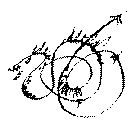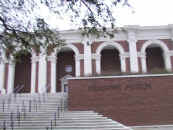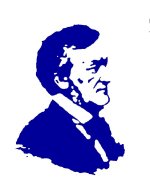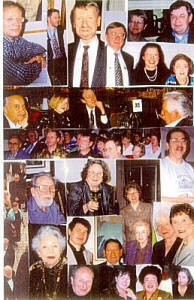|
The
Wagner Society |
|
|
A LECTURE BY
|
WSD EVENTS
|
Weimar, Liszt, and Richard Wagner
The Musical Impact on German Culture
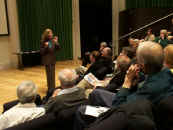
Web Page: www.tourofthearts.com
E-mail: info@TouroftheArts.com
PROGRAM
Weimar, Liszt, and Richard Wagner
The Musical Impact on German Culture
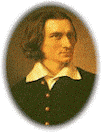 Richard
Wagner and Franz Liszt met in Weimar for a fateful three days in 1849.
Wagner was on the lam, fleeing a warrant for his arrest in Dresden, 47 miles
away, because of his recent activities there as a revolutionary. Liszt had been living
in Weimar with his paramour, the Countess Carolyne von Sayn-Wittgenstein.
Richard
Wagner and Franz Liszt met in Weimar for a fateful three days in 1849.
Wagner was on the lam, fleeing a warrant for his arrest in Dresden, 47 miles
away, because of his recent activities there as a revolutionary. Liszt had been living
in Weimar with his paramour, the Countess Carolyne von Sayn-Wittgenstein.
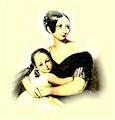 Liszt
was the retired piano virtuoso, the toast of all Europe. He had come to Weimar
in 1848 to live with Carolyne, to put his life as a famed performer behind
him, and to devote himself to serious composition.
Liszt
was the retired piano virtuoso, the toast of all Europe. He had come to Weimar
in 1848 to live with Carolyne, to put his life as a famed performer behind
him, and to devote himself to serious composition.
At the time of his arrival, Weimar was the City of Goethe, the German literary hero. Since Goethe's death, the city had begun the process of mythologizing Goethe. Liszt, the upstart new arrival, was disliked because he and Carolyne had set themselves up in Die Altenberg, Carolyn's castle outside of town, instead of in town, with the intention of creating the New Music Capital of Europe. They snubbed the local citizens, the torch bearers of the old way, who were thus offended. As a result, to this day, the citizens of Weimar ignore Liszt's presence in the city, instead deifying Goethe.
When Wagner fled to Liszt in Weimar, upon his arrival there, he did not at first tell Liszt and Carolyne of his political troubles. Instead, they discussed music and art. Liszt conducted a rehearsal of Tannhauser, and Wagner was impressed. He proposed a new opera based on the life of Jesus of Nazareth. Franz and Carolyne though it was a bad idea. Wagner even proposed that Weimar become the site of his new Festspielhaus, an idea which later came to fruition in Bayreuth instead. How different it would be if Weimer had become the site of the Annual Wagner Festival!
Wagner finally had to tell Liszt about his political troubles and fled again, ending up for a time in Paris and London before finally setting in Zurich. He remained in exile from Germany for 12 years, spending the time profitably by writing and composing Tristan und Isolde and Der Ring des Niebelungen, among other things.
Liszt had first become aware of Wagner the composer through performances of Rienzi in Dresden. In 1850, he gave the first performances of Wagner's new opera, Lohengrin. During Wagner's exile, Liszt became his champion as the future of German music and art. Not only did he regularly send Richard money and arrange for other financial support, but he also promoted Wagner's operas Tannhauser and Lohengrin in German opera theatres. His activities as Wagner's biggest fan assured Wagner of a secure position back home, when he was finally pardoned in 1862 of his political indiscretions.
Liszt, of course, was also the champion of many other composers of the day, including Berlioz, whose Les Troyens was first performed in Weimar. And Wagner went on to marry Liszt's daughter, Cosima, who became important in the creation of the Wagner Festival at Bayreuth.
Sadly, Liszt was never able to marry Carolyn von Sayn-Wittgenstein, because the Catholic Church refused to grant her a divorce. As a result, he eventually devoted himself to religion, taking minor orders as an Abbe in the Franciscan order. He continued to compose throughout his life, with mixed results. His early and flamboyant piano music is still widely performed. He single-handedly invented the tone poem, with works like Tasso and Les Preludes. But his oratorios and sacred music remain largely unperformed today. And his musical style can vary quite widely, from flashy virtuoso pieces to harmonically and structurally inventive forms, and finally to dull oratorios and choruses. Still, Liszt is an important composer whose music continues to be respected, and his support of Wagner in difficult times contributed to the success of one of the greatest of 19th Century geniuses.
Ed Flaspoehler, WSD, March 17, 2002.
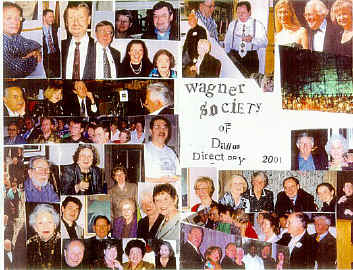

Welcome to The Wagner Society of Dallas. You know, as Texans, we're bound to strive for being the biggest and best of all the Wagner groups in the world over. My hope, in addition, is that we ensure your attendance and participation by offering an interesting, stimulating, and enjoyable array of meetings, recitals, and travel. Let us know if you have suggestions for future activities, and do make an effort to join in during the coming months with your membership, attendance, and above all joy of being with fellow Wagner aficionados. Roger Carroll The Wagner Society of Dallas - Virginia R.
Abdo and Dr. James T. Wheeler, The Wagner Society of Dallas is devoted to furthering the enjoyment and appreciation of the music of Richard Wagner. The Dallas group is one of many Wagner Societies all over the world. It is a non-profit organization open to anyone who enjoys the works of Richard Wagner and who would like to participate in the Society’s activities. The Wagner Society of Dallas has monthly meetings and programs which feature recitals, lectures, video screenings, receptions for opera singers and personalities, and trips to Wagner performances in other cities. We welcome music lovers who are already familiar with Wagner’s works as well as those who may want to become more knowledgeable about Wagner’s music. Member Benefits include attendance at programs, our newsletter, discount on books and CD’s, advance notice of events and selected ticket services, receipt of the Membership Directory, ticket allotments to Bayreuth, and an active link with fellow Wagnerians throughout the world. |
